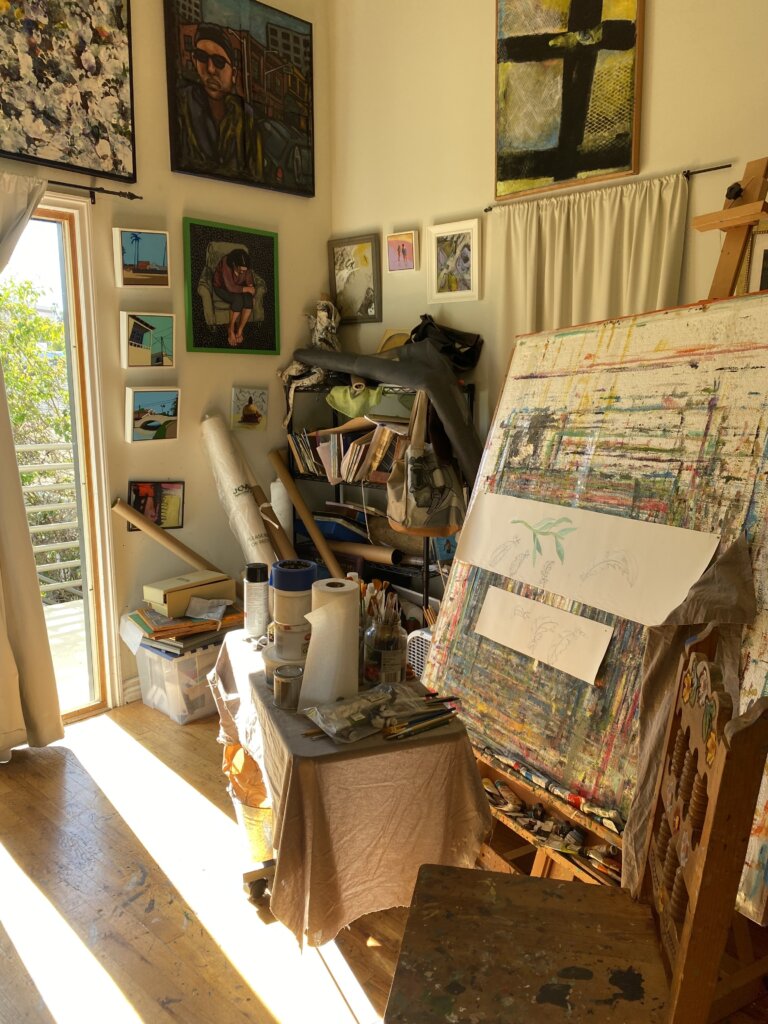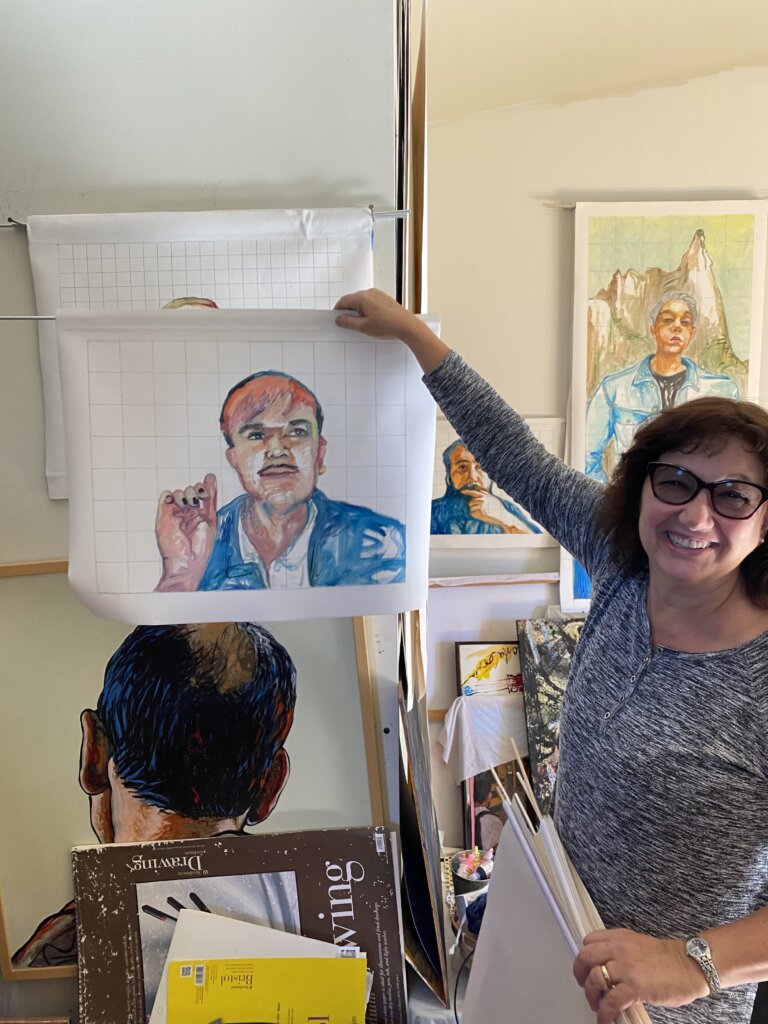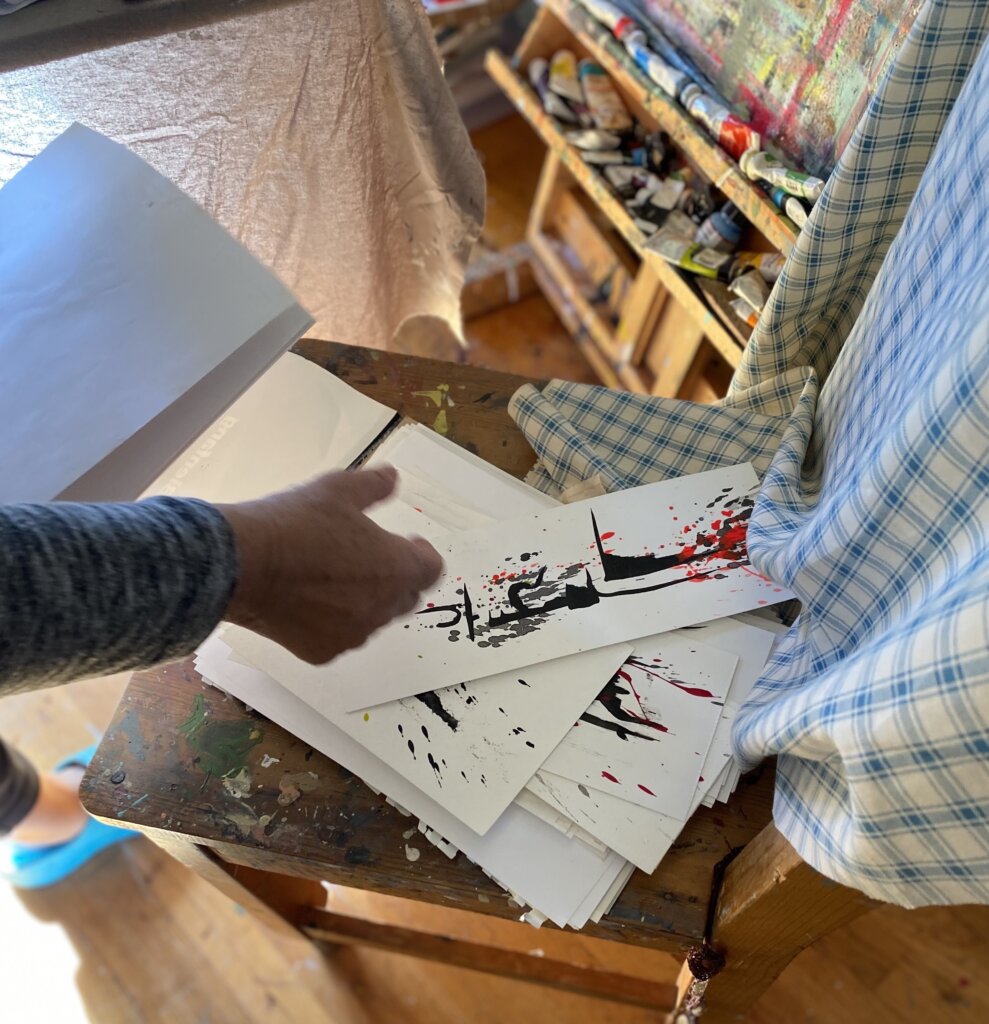
Photo EssayThis artist paints portraits of today’s Yiddishists
Three works by Los Angeles-based artist Silvia Wagensberg are on display at UCLA Hillel.
Graphic by Angelie Zaslavsky
Photo EssayThis artist paints portraits of today’s Yiddishists
Three works by Los Angeles-based artist Silvia Wagensberg are on display at UCLA Hillel.
Silvia Wagensberg, an artist and retired Spanish teacher, was happy to have the Forverts come and interview her — it was, after all, a publication she has a personal history with.
In December 2010, Forverts editor Boris Sandler and associate editor Itzik Gottesman flew out to Los Angeles to present. Wagensberg volunteered her airy Venice neighborhood home for a Hanukkah shindig through the California Institute for Yiddish Culture & Language (CICYL) — “The Forverts came here and I offered my house and it was a big party,” Wagensberg said.
That happened back when she was just beginning to get involved with CICYL, a group founded and run by her neighbor, UCLA Yiddish lecturer Miri Koral. She turned to Koral to begin her Yiddish study.
Wagensberg wanted to speak the language her parents once spoke to each other, but not to her. It’s a typical story, she said. “Once I started learning Yiddish, I saw so many people of my generation that had exactly the same experience.”
Wagensberg was born and raised in Barcelona. Her parents left Poland in the 1930s to escape antisemitism. Although she grew up hearing Yiddish, the languages she learned to speak were Spanish and French. She didn’t learn Catalan, the regional language of Catalonia where Barcelona is located, until later in life. Under the dictatorship of Francisco Franco, which lasted until 1975, she heard Catalan only at friends’ homes — not in public. After Spain transitioned to democracy and the teaching of Catalan was legalized, she learned the language.
Languages were always part of Wagensberg’s life. She studied philology in her university. She moved to the United States in 1987, eventually becoming a Spanish teacher at Venice High School.
Before emigrating, Wagensberg also took art classes in Spain — and to this day, she paints people, places and emotions of her life: her Spanish students; people who visit or attend the Yiddish class she is taking; the canals of Venice, California, and abstract reflections of her inner feelings. Her portraits of Yiddishists and her Yiddish calligraphy are unique in that they don’t center on an idealized past but on the present.
1 / 6

Photo by Zach Golden
Wagensberg’s studio is located on the second floor of a back house, where on a sunny day, the light pours in. The peace and quiet here is rare for urban Los Angeles, and part of the charm is the calmness that blankets the room, punctuated by the sound of chirping birds outside. You notice the variety of artistic styles immediately: three small, blue, and realistic depictions of Venice are displayed below an abstract painting. Wagensberg changes her color palette based on “the mood of what’s going on around me or in the country, in the whole world.”
2 / 6

Photo by Zach Golden
Wagensberg started sketching Yiddishists in 2016 from photos, but during the pandemic, she captured many from the flat angle of a Zoom screen, which significantly changed the depth of their appearance. The sketch Wagensberg is holding here is of Tomas Woodski, the Yiddish-language TV host from Sweden, who was a guest at an online Workers’ Circle class she attended. Her pen has traced the faces of well-known Yiddishists like YUNG YiDiSH founder Mendy Cahan, scholar Barbara Kirschenblatt-Gimblett, linguist Yitskhok Niborski and many others. She also sketches fellow students. Many of her subjects are often not aware they are being sketched — which is why she displays them publicly only with their first names.
3 / 6

On this table, Wagensberg has stacks of what she describes as Yiddish calligraphy. The words are largely indecipherable. She paints these as she sits through class (an imaginative version of note-taking); they invoke the frustration of language learning and the beauty of the language at the same time.
Wagensberg describes language learning as a worthwhile struggle. “I’ve been learning different languages. And this is a process of painful frustration. I don’t think I’m especially good at it. But I’m persistent with it, and I end up learning and then it’s a good feeling of ‘oh my God, I can read the Forverts.’”
4 / 6

A painting of Wagensberg’s grandmother Beyle, whom she would visit as a child. “She spoke no Spanish,” the artist said.
5 / 6

Wagensberg’s paintings of Yiddishists Yehuda Blum, Pearl Gluck and Miriam Isaacs are now on display as part of a multi-artist exhibition by the Jewish Artists Initiative hosted by UCLA Hillel, “Jewish Artists Capturing Sense of Self & Community,” that is running at UCLA’s Hillel until March 24.
She describes these paintings as belonging to a large collection of portraits of groups she belongs to; this group here is from her online Yiddish class, which started during the COVID pandemic.
6 / 6

At the opening reception to the exhibit, Perla Kearney, the UCLA Hillel Artistic Director (who co-starred together with actor Mike Burstyn in this Forverts deli video), and USC professor and artist Ruth Weisberg, were among the speakers. Weisberg, pictured here, spoke about the need for Jewish art.
“I think that there are many forces in our culture, some of them kind of disturbing, that would have us be less Jewish. And I’m here to say, let’s be more Jewish. And one way we explore that and share is through our art.”
Wagensberg has publicly displayed her portraits of Yiddishists before as solo shows, once before at UCLA Hillel in 2017, and once at Loyola Marymount University in Los Angeles in 2019 — but this showing is different. Her Yiddishist portraits are not on their own this time, isolated from the Jewish artistic mainstream. Instead, they are part of an exhibition of many different Jewish artists, weaving the faces of the contemporary Yiddish world into the tapestry of collective Jewish expression.























